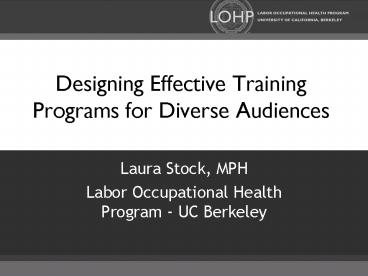Designing Effective Training Programs for Diverse Audiences - PowerPoint PPT Presentation
1 / 20
Title:
Designing Effective Training Programs for Diverse Audiences
Description:
Designing Effective Training Programs for Diverse Audiences Laura Stock, MPH Labor Occupational Health Program - UC Berkeley * * * * * Curriculum Design Criteria ... – PowerPoint PPT presentation
Number of Views:91
Avg rating:3.0/5.0
Title: Designing Effective Training Programs for Diverse Audiences
1
Designing Effective Training Programs for Diverse
Audiences
- Laura Stock, MPH
- Labor Occupational Health Program - UC Berkeley
2
Curriculum Design Criteria
- Based on adult learning principles
- Appropriate for diverse populations with
differences in language, literacy, culture - Action-oriented will provide skills and
information that can be used and applied - Technically accurate
- Activities enhance confidence and leadership
skills
3
Adults Learn Best When Curriculum
- Is Relevant
- Respects Participants
- Builds on Previous Learning
- Uses Diverse Methods
- Is Participatory and Interactive
4
Steps in Curriculum Planning
- Form a curriculum development team
- Do a needs assessment
- Set objectives and identify content areas
- Select teaching methods
- Develop the lesson plans
- Pilot test the program
- Evaluate and revise as needed
5
Needs Assessment What do you want to know?
- Nature of audience language, culture, literacy,
educational level - What are their concerns/needs/interests why are
they there? - What kind of training/info on your topic have
they already received? - How do they learn best what kind of written
material do they prefer - How do they hope to use the information/skills
6
Setting Learning Objectives Hit the Bulls Eye
7
Setting Objectives What do people need to know
- Knowledge
- Attitudes
- Skills
- Communication skills
- Speaking up when there is a problem
- Problem solving
8
Selecting Teaching Methods Use Diverse Methods
- Tell me I Forget
- Show me I Remember
- Involve me I Understand
9
Participatory Training Methods
- Reflect adult learning principles
- Draw on participants own experience
- Encourage teamwork and group problem solving
- Work well with people with reading or writing
difficulties - Emphasize learning through doing
- Create a comfortable learning environment
- Provide opportunity to practice new skills
10
Participatory Methods Examples
- Brainstorm
- Role Plays
- Games
- Small Group Activities Case Studies
- Demonstrations
- Hands-on Practice
- Question and Answer
11
Literacy Issues
- According to National Adult Literacy Survey, 50
of all adults have trouble with tasks that
involve speaking, reading, and writing. - People tend to hide their reading and writing
problems - People have developed very creative coping
strategies - You cant expect people to self-identify nor may
you be able to tell if there are literacy
problems
12
Cultural Diversity
- People will bring a variety of perspectives to
class - There may be different attitudes to speaking up,
making changes, asking questions, etc.
13
Adapting for Language and Literacy
- Try to learn about your audience in advance
- Identify languages spoken. If needed, offer
training and materials in multiple languages - Since you cant identify who has reading and
writing problems, assume a range of skills and
make training accessible for everyone - Avoid putting people on the spot. Always ask for
volunteer readers or writers
14
Adapting, cont.
- Use visual aids and read aloud what you write on
flipchart - Show respect and appreciation for cultural
differences be prepared to change references to
local culture, pop icons, history, etc. - Link with community based organizations who
represent your target population to learn and to
share resources
15
Developing Written Materials for Diverse Audiences
- Establish priority message the bulls eye
- Organize text into short, logical sections
- Use plain language and words that are easy to
understand - Define technical terms
- Have sufficient white space
- Use illustrations to explain text
16
Adapting Materials Example
17
Translation/Interpretation Issues
- What words are commonly used? Have you considered
regional differences? - Do you need to adapt, not just translate?
- Have you involved the target audience in
reviewing/pilot testing the translation - Do you have good bilingual instructors? Can they
translate concepts not just words?
18
Pilot Test, Evaluate and Revise
- Assess
- The degree of change in knowledge, attitude, or
skills that was intended - The effectiveness of the teaching methods used
- Usefulness of materials
- Appropriateness, relevance of course content
19
Assessing Participant Skills
- Written tests
- In class assessment techniques
- Role plays demonstrating skills
- Small group presentations
20
Summary of Key Criteria
- Reflects commitment to adult learning principles
- Methods match objectives
- Program is accessible/appropriate for diverse
audience - Aim for the bulls-eye































